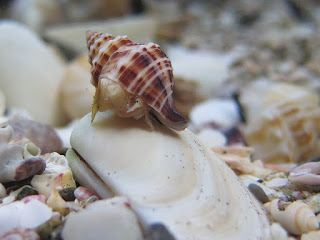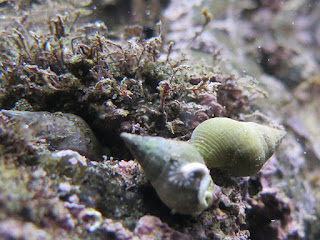 |
| Stingray 'pit', Te Matuku marine reserve, Waiheke Island, 25/11/16. |
There are three species of stingray found in New Zealand waters and the most common is the short-tailed stingray (Dasyatis brevicaudata (Hutton, 1875)), which can grow up to 4.3m, making them the largest stingrays in the world.
 |
| Another stingray 'pit', Te Matuku marine reserve, Waiheke Island, 25/11/16. |
In the first picture, the orientation of the stingray was such that the head was pointing down to the right, so that its mouth was over where the dark hole in the mud is now. The ray then liquified the sediment beneath its head so that it could get to the invertebrates buried below the surface. If you look carefully you can see its outline in the mud. In the second picture the ray's orientation is with the mouth pointing towards the upper left of the picture. I've sharpened this shot a little to try and bring out a bit more detail.
It is thought that short-tailed stingray feed on crabs and bivalves (Ayling & Cox 1982), but these data are quite old and probably could be updated in light of the invasive species now found in the Auckland region. Stingrays share their habitat with a number of new arrivals, several of which could now be prey items.
Recent research on a closely related species from Japan has revealed that stingrays are bioengineers, and are important in the turnover and re-oxygenation of sediments (Takeucki & Tamaki 2014). By digging these pits, stingrays may therefore help to maintain a healthy mudflat ecosystem.
More info:
http://www.seafriends.org.nz/issues/res/pk/stingrays.htm#short-tailed_sting_ray
http://phys.org/news/2016-09-stingrays-food-swallowing.html
Ayling, T, Cox GJ 1982. Collins guide to the sea fishes of New Zealand. Collins, Auckland, New Zealand.
Takeuchi S, Tamaki A 2014. Assessment of benthic disturbance associated with stingray foraging for ghost shrimp by aerial survey over an intertidal sandflat. Continental Shelf Research, 84, 139–157.
















































